Public Health Analysis: Asthma Check-up for a 35-Year-Old Asian Lady
VerifiedAdded on 2023/04/23
|9
|2616
|499
Essay
AI Summary
This essay provides a comprehensive public health analysis of a 35-year-old Asian woman named Maryanne, who seeks an asthma check-up. It explores relevant demographic data such as age, sex, ethnicity, employment status, and educational achievement, and delves into physical, mental, and social health measures pertinent to asthmatic individuals. The essay identifies potential health risks Maryanne currently faces, including fatigue, underperformance at work, and psychological stress due to her busy lifestyle and single-parent status. It defines health screening, discusses its advantages and disadvantages, and suggests spirometry as a suitable screening test for Maryanne, recommending referrals to respiratory specialists for further advice. The analysis emphasizes the importance of measuring health to improve care, allocate resources effectively, and monitor changes in health status.
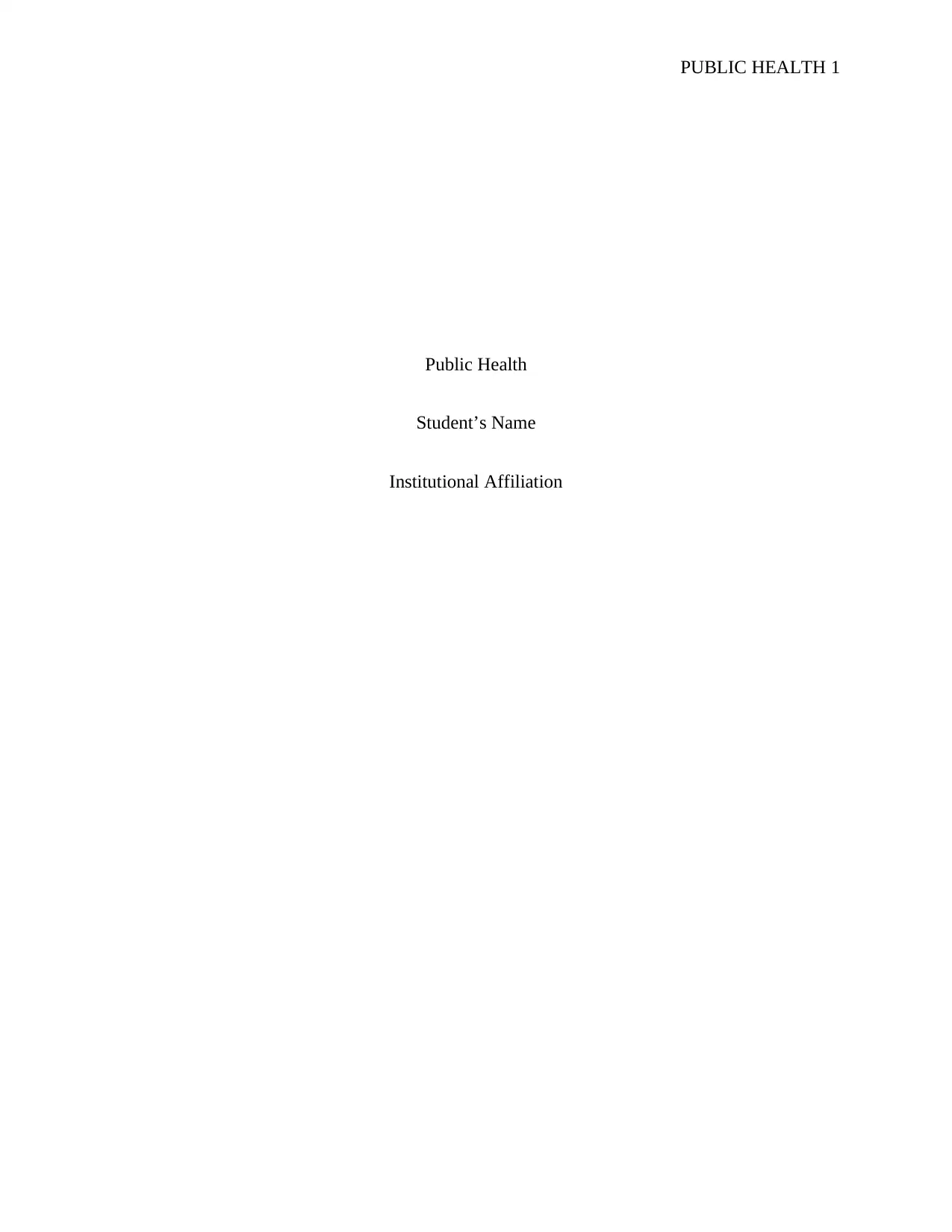
PUBLIC HEALTH 1
Public Health
Student’s Name
Institutional Affiliation
Public Health
Student’s Name
Institutional Affiliation
Paraphrase This Document
Need a fresh take? Get an instant paraphrase of this document with our AI Paraphraser
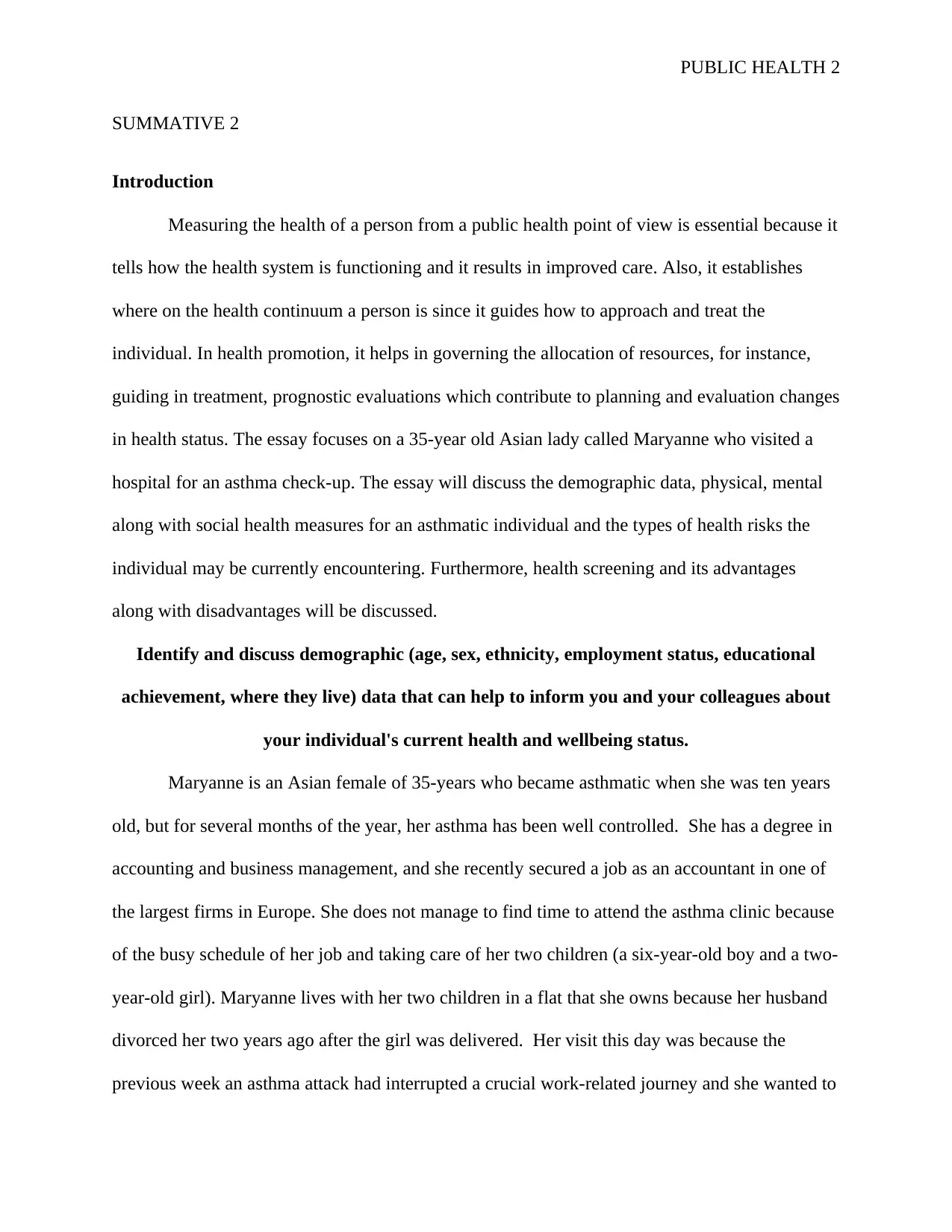
PUBLIC HEALTH 2
SUMMATIVE 2
Introduction
Measuring the health of a person from a public health point of view is essential because it
tells how the health system is functioning and it results in improved care. Also, it establishes
where on the health continuum a person is since it guides how to approach and treat the
individual. In health promotion, it helps in governing the allocation of resources, for instance,
guiding in treatment, prognostic evaluations which contribute to planning and evaluation changes
in health status. The essay focuses on a 35-year old Asian lady called Maryanne who visited a
hospital for an asthma check-up. The essay will discuss the demographic data, physical, mental
along with social health measures for an asthmatic individual and the types of health risks the
individual may be currently encountering. Furthermore, health screening and its advantages
along with disadvantages will be discussed.
Identify and discuss demographic (age, sex, ethnicity, employment status, educational
achievement, where they live) data that can help to inform you and your colleagues about
your individual's current health and wellbeing status.
Maryanne is an Asian female of 35-years who became asthmatic when she was ten years
old, but for several months of the year, her asthma has been well controlled. She has a degree in
accounting and business management, and she recently secured a job as an accountant in one of
the largest firms in Europe. She does not manage to find time to attend the asthma clinic because
of the busy schedule of her job and taking care of her two children (a six-year-old boy and a two-
year-old girl). Maryanne lives with her two children in a flat that she owns because her husband
divorced her two years ago after the girl was delivered. Her visit this day was because the
previous week an asthma attack had interrupted a crucial work-related journey and she wanted to
SUMMATIVE 2
Introduction
Measuring the health of a person from a public health point of view is essential because it
tells how the health system is functioning and it results in improved care. Also, it establishes
where on the health continuum a person is since it guides how to approach and treat the
individual. In health promotion, it helps in governing the allocation of resources, for instance,
guiding in treatment, prognostic evaluations which contribute to planning and evaluation changes
in health status. The essay focuses on a 35-year old Asian lady called Maryanne who visited a
hospital for an asthma check-up. The essay will discuss the demographic data, physical, mental
along with social health measures for an asthmatic individual and the types of health risks the
individual may be currently encountering. Furthermore, health screening and its advantages
along with disadvantages will be discussed.
Identify and discuss demographic (age, sex, ethnicity, employment status, educational
achievement, where they live) data that can help to inform you and your colleagues about
your individual's current health and wellbeing status.
Maryanne is an Asian female of 35-years who became asthmatic when she was ten years
old, but for several months of the year, her asthma has been well controlled. She has a degree in
accounting and business management, and she recently secured a job as an accountant in one of
the largest firms in Europe. She does not manage to find time to attend the asthma clinic because
of the busy schedule of her job and taking care of her two children (a six-year-old boy and a two-
year-old girl). Maryanne lives with her two children in a flat that she owns because her husband
divorced her two years ago after the girl was delivered. Her visit this day was because the
previous week an asthma attack had interrupted a crucial work-related journey and she wanted to
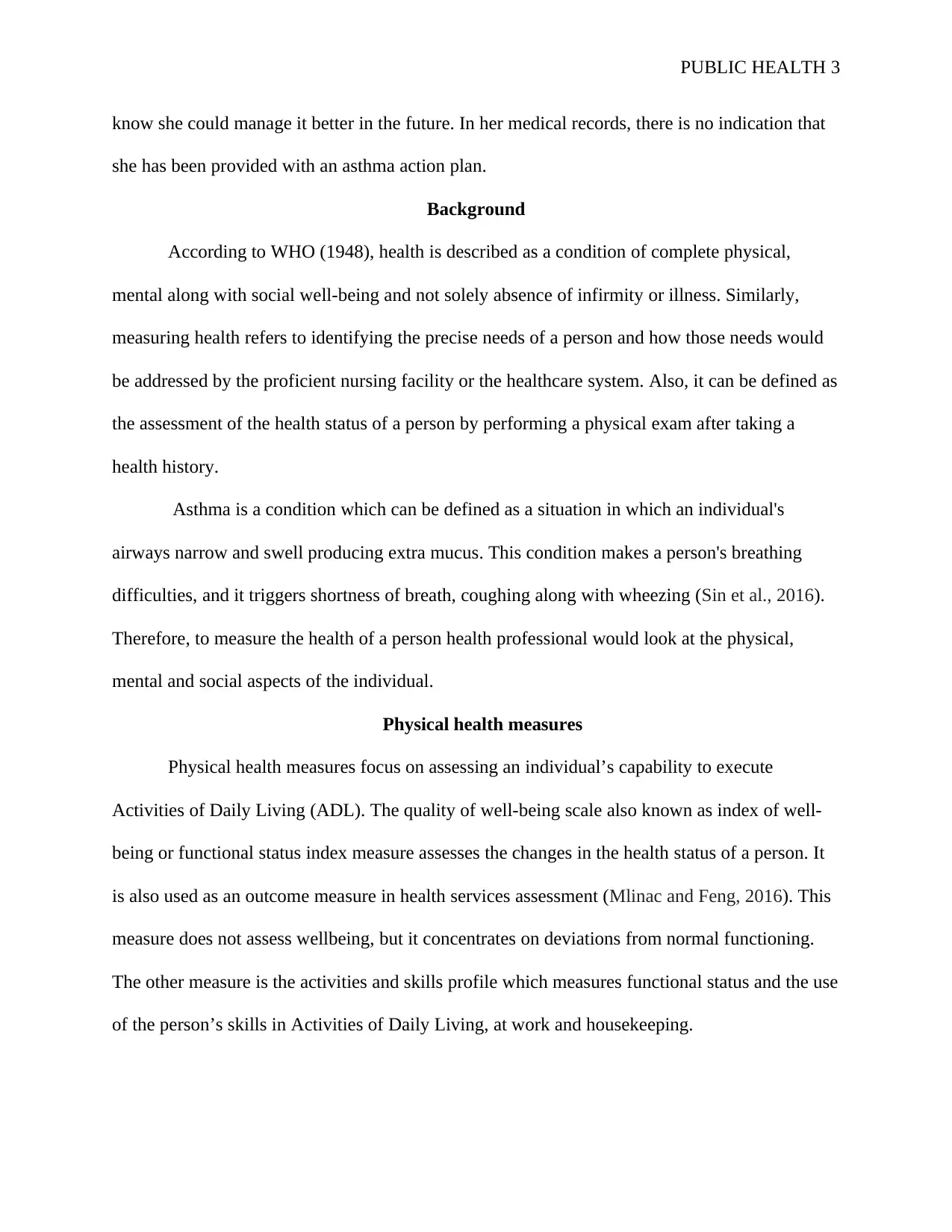
PUBLIC HEALTH 3
know she could manage it better in the future. In her medical records, there is no indication that
she has been provided with an asthma action plan.
Background
According to WHO (1948), health is described as a condition of complete physical,
mental along with social well-being and not solely absence of infirmity or illness. Similarly,
measuring health refers to identifying the precise needs of a person and how those needs would
be addressed by the proficient nursing facility or the healthcare system. Also, it can be defined as
the assessment of the health status of a person by performing a physical exam after taking a
health history.
Asthma is a condition which can be defined as a situation in which an individual's
airways narrow and swell producing extra mucus. This condition makes a person's breathing
difficulties, and it triggers shortness of breath, coughing along with wheezing (Sin et al., 2016).
Therefore, to measure the health of a person health professional would look at the physical,
mental and social aspects of the individual.
Physical health measures
Physical health measures focus on assessing an individual’s capability to execute
Activities of Daily Living (ADL). The quality of well-being scale also known as index of well-
being or functional status index measure assesses the changes in the health status of a person. It
is also used as an outcome measure in health services assessment (Mlinac and Feng, 2016). This
measure does not assess wellbeing, but it concentrates on deviations from normal functioning.
The other measure is the activities and skills profile which measures functional status and the use
of the person’s skills in Activities of Daily Living, at work and housekeeping.
know she could manage it better in the future. In her medical records, there is no indication that
she has been provided with an asthma action plan.
Background
According to WHO (1948), health is described as a condition of complete physical,
mental along with social well-being and not solely absence of infirmity or illness. Similarly,
measuring health refers to identifying the precise needs of a person and how those needs would
be addressed by the proficient nursing facility or the healthcare system. Also, it can be defined as
the assessment of the health status of a person by performing a physical exam after taking a
health history.
Asthma is a condition which can be defined as a situation in which an individual's
airways narrow and swell producing extra mucus. This condition makes a person's breathing
difficulties, and it triggers shortness of breath, coughing along with wheezing (Sin et al., 2016).
Therefore, to measure the health of a person health professional would look at the physical,
mental and social aspects of the individual.
Physical health measures
Physical health measures focus on assessing an individual’s capability to execute
Activities of Daily Living (ADL). The quality of well-being scale also known as index of well-
being or functional status index measure assesses the changes in the health status of a person. It
is also used as an outcome measure in health services assessment (Mlinac and Feng, 2016). This
measure does not assess wellbeing, but it concentrates on deviations from normal functioning.
The other measure is the activities and skills profile which measures functional status and the use
of the person’s skills in Activities of Daily Living, at work and housekeeping.
⊘ This is a preview!⊘
Do you want full access?
Subscribe today to unlock all pages.

Trusted by 1+ million students worldwide

PUBLIC HEALTH 4
It is recommended that to improve the physical health of asthmatic person she must be
encouraged to eat healthy by eating plenty of fruits and vegetables daily. Also, physical training
should be recommended as part of asthma management for its beneficial impact on life quality.
Mental health (wellbeing) measures
Psychiatric health measures cover short-term mental conditions rather than lasting traits
and describe human psychological responses in adapting to the surrounding. One of the measures
is the general well-being schedule which includes the measures of anxiety, public health, self-
control vitality and positive well-being (Li, Lan, and Ju, 2015). The other measure is the mental
health inventory which considers behavioral or emotional control, depression and emotional ties
to predict the use of the service. This measure is regarded as a perfect alternative for General
Well-being Schedule and is approved as a case detection instrument. Lastly, the Bradburn’s scale
measure covers negative and positive emotional reactions to the stresses of daily living. It
indicates the psychological responses of a person to events in their daily lives (Lindert et al.,
2015).
In measuring mental health of a person, the health professionals first identify the
outcomes they need to measure to prove their hypothesis. Next, they use international standards
to define mental illnesses. These standards include the Diagnostic Statistical Manual Version 5
(DSM-V) and the International Classification of Disease version 10 (ICD-10). Finally, they
commit to utilizing a pre-existing screening tool to assess mental health and its related factors.
Social health measures
Social health of a person is measured by assessing an individual's satisfaction with her
relationship or her performance of several social roles. McFarlane scale measure determines the
extent of a person's network of contacts and its perceived usefulness in minimizing the impacts
It is recommended that to improve the physical health of asthmatic person she must be
encouraged to eat healthy by eating plenty of fruits and vegetables daily. Also, physical training
should be recommended as part of asthma management for its beneficial impact on life quality.
Mental health (wellbeing) measures
Psychiatric health measures cover short-term mental conditions rather than lasting traits
and describe human psychological responses in adapting to the surrounding. One of the measures
is the general well-being schedule which includes the measures of anxiety, public health, self-
control vitality and positive well-being (Li, Lan, and Ju, 2015). The other measure is the mental
health inventory which considers behavioral or emotional control, depression and emotional ties
to predict the use of the service. This measure is regarded as a perfect alternative for General
Well-being Schedule and is approved as a case detection instrument. Lastly, the Bradburn’s scale
measure covers negative and positive emotional reactions to the stresses of daily living. It
indicates the psychological responses of a person to events in their daily lives (Lindert et al.,
2015).
In measuring mental health of a person, the health professionals first identify the
outcomes they need to measure to prove their hypothesis. Next, they use international standards
to define mental illnesses. These standards include the Diagnostic Statistical Manual Version 5
(DSM-V) and the International Classification of Disease version 10 (ICD-10). Finally, they
commit to utilizing a pre-existing screening tool to assess mental health and its related factors.
Social health measures
Social health of a person is measured by assessing an individual's satisfaction with her
relationship or her performance of several social roles. McFarlane scale measure determines the
extent of a person's network of contacts and its perceived usefulness in minimizing the impacts
Paraphrase This Document
Need a fresh take? Get an instant paraphrase of this document with our AI Paraphraser
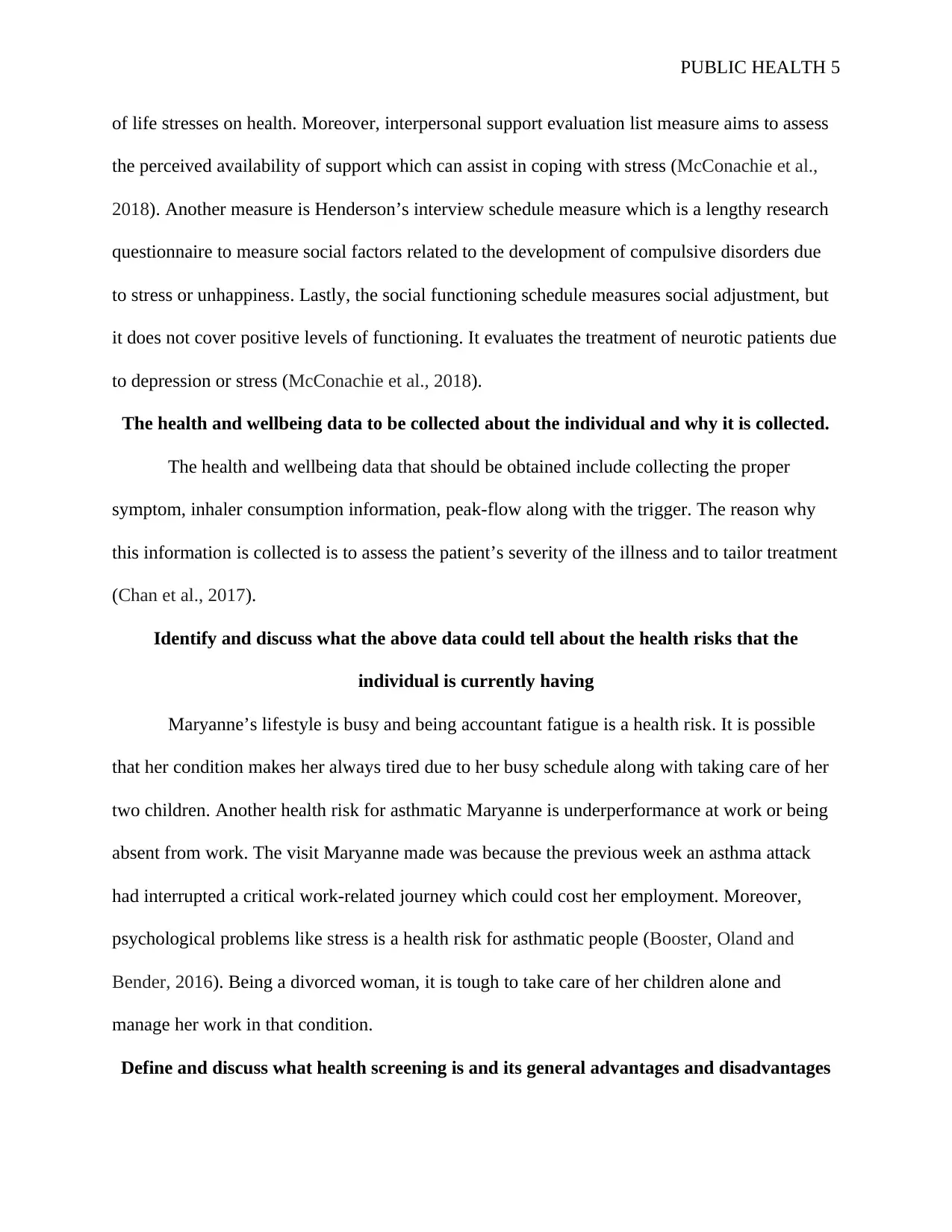
PUBLIC HEALTH 5
of life stresses on health. Moreover, interpersonal support evaluation list measure aims to assess
the perceived availability of support which can assist in coping with stress (McConachie et al.,
2018). Another measure is Henderson’s interview schedule measure which is a lengthy research
questionnaire to measure social factors related to the development of compulsive disorders due
to stress or unhappiness. Lastly, the social functioning schedule measures social adjustment, but
it does not cover positive levels of functioning. It evaluates the treatment of neurotic patients due
to depression or stress (McConachie et al., 2018).
The health and wellbeing data to be collected about the individual and why it is collected.
The health and wellbeing data that should be obtained include collecting the proper
symptom, inhaler consumption information, peak-flow along with the trigger. The reason why
this information is collected is to assess the patient’s severity of the illness and to tailor treatment
(Chan et al., 2017).
Identify and discuss what the above data could tell about the health risks that the
individual is currently having
Maryanne’s lifestyle is busy and being accountant fatigue is a health risk. It is possible
that her condition makes her always tired due to her busy schedule along with taking care of her
two children. Another health risk for asthmatic Maryanne is underperformance at work or being
absent from work. The visit Maryanne made was because the previous week an asthma attack
had interrupted a critical work-related journey which could cost her employment. Moreover,
psychological problems like stress is a health risk for asthmatic people (Booster, Oland and
Bender, 2016). Being a divorced woman, it is tough to take care of her children alone and
manage her work in that condition.
Define and discuss what health screening is and its general advantages and disadvantages
of life stresses on health. Moreover, interpersonal support evaluation list measure aims to assess
the perceived availability of support which can assist in coping with stress (McConachie et al.,
2018). Another measure is Henderson’s interview schedule measure which is a lengthy research
questionnaire to measure social factors related to the development of compulsive disorders due
to stress or unhappiness. Lastly, the social functioning schedule measures social adjustment, but
it does not cover positive levels of functioning. It evaluates the treatment of neurotic patients due
to depression or stress (McConachie et al., 2018).
The health and wellbeing data to be collected about the individual and why it is collected.
The health and wellbeing data that should be obtained include collecting the proper
symptom, inhaler consumption information, peak-flow along with the trigger. The reason why
this information is collected is to assess the patient’s severity of the illness and to tailor treatment
(Chan et al., 2017).
Identify and discuss what the above data could tell about the health risks that the
individual is currently having
Maryanne’s lifestyle is busy and being accountant fatigue is a health risk. It is possible
that her condition makes her always tired due to her busy schedule along with taking care of her
two children. Another health risk for asthmatic Maryanne is underperformance at work or being
absent from work. The visit Maryanne made was because the previous week an asthma attack
had interrupted a critical work-related journey which could cost her employment. Moreover,
psychological problems like stress is a health risk for asthmatic people (Booster, Oland and
Bender, 2016). Being a divorced woman, it is tough to take care of her children alone and
manage her work in that condition.
Define and discuss what health screening is and its general advantages and disadvantages
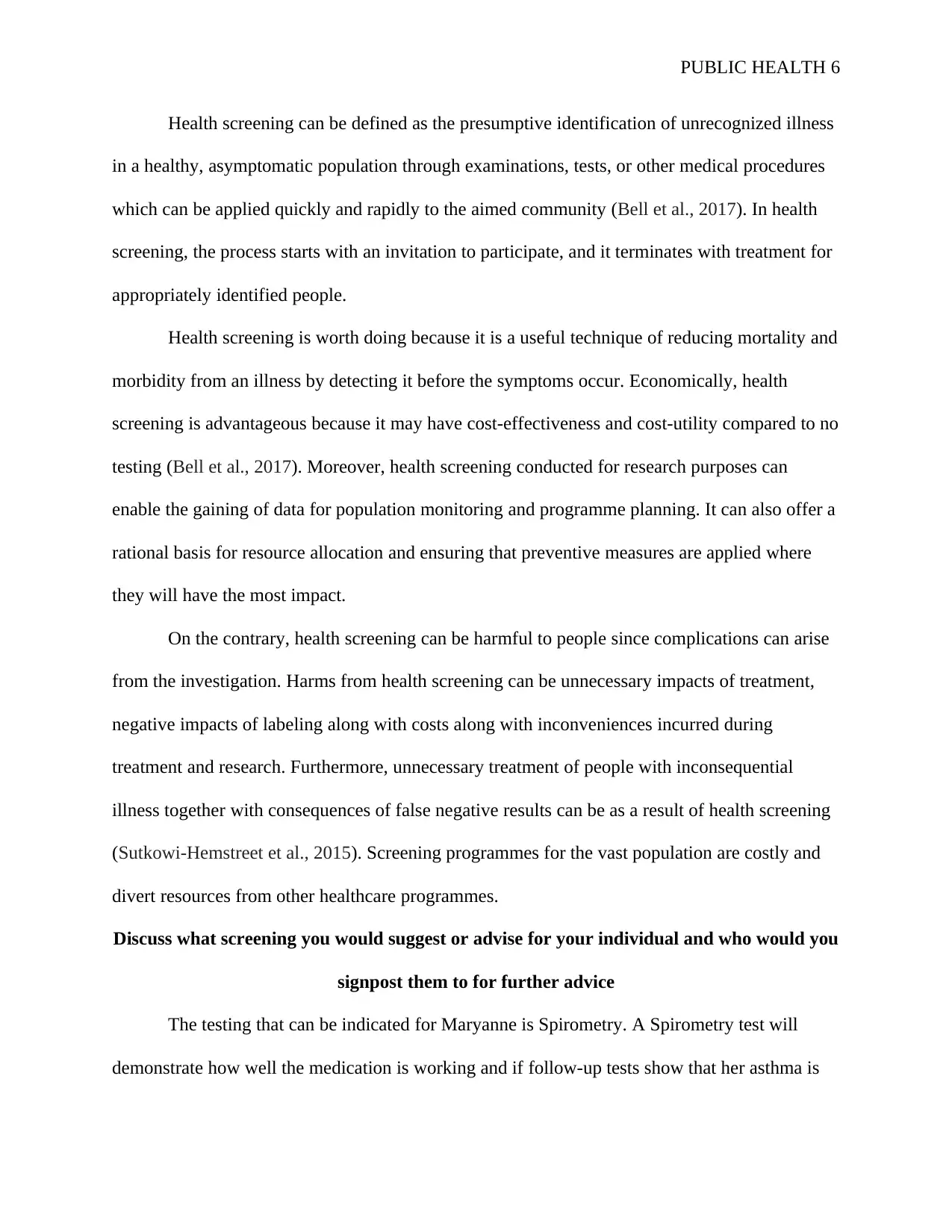
PUBLIC HEALTH 6
Health screening can be defined as the presumptive identification of unrecognized illness
in a healthy, asymptomatic population through examinations, tests, or other medical procedures
which can be applied quickly and rapidly to the aimed community (Bell et al., 2017). In health
screening, the process starts with an invitation to participate, and it terminates with treatment for
appropriately identified people.
Health screening is worth doing because it is a useful technique of reducing mortality and
morbidity from an illness by detecting it before the symptoms occur. Economically, health
screening is advantageous because it may have cost-effectiveness and cost-utility compared to no
testing (Bell et al., 2017). Moreover, health screening conducted for research purposes can
enable the gaining of data for population monitoring and programme planning. It can also offer a
rational basis for resource allocation and ensuring that preventive measures are applied where
they will have the most impact.
On the contrary, health screening can be harmful to people since complications can arise
from the investigation. Harms from health screening can be unnecessary impacts of treatment,
negative impacts of labeling along with costs along with inconveniences incurred during
treatment and research. Furthermore, unnecessary treatment of people with inconsequential
illness together with consequences of false negative results can be as a result of health screening
(Sutkowi-Hemstreet et al., 2015). Screening programmes for the vast population are costly and
divert resources from other healthcare programmes.
Discuss what screening you would suggest or advise for your individual and who would you
signpost them to for further advice
The testing that can be indicated for Maryanne is Spirometry. A Spirometry test will
demonstrate how well the medication is working and if follow-up tests show that her asthma is
Health screening can be defined as the presumptive identification of unrecognized illness
in a healthy, asymptomatic population through examinations, tests, or other medical procedures
which can be applied quickly and rapidly to the aimed community (Bell et al., 2017). In health
screening, the process starts with an invitation to participate, and it terminates with treatment for
appropriately identified people.
Health screening is worth doing because it is a useful technique of reducing mortality and
morbidity from an illness by detecting it before the symptoms occur. Economically, health
screening is advantageous because it may have cost-effectiveness and cost-utility compared to no
testing (Bell et al., 2017). Moreover, health screening conducted for research purposes can
enable the gaining of data for population monitoring and programme planning. It can also offer a
rational basis for resource allocation and ensuring that preventive measures are applied where
they will have the most impact.
On the contrary, health screening can be harmful to people since complications can arise
from the investigation. Harms from health screening can be unnecessary impacts of treatment,
negative impacts of labeling along with costs along with inconveniences incurred during
treatment and research. Furthermore, unnecessary treatment of people with inconsequential
illness together with consequences of false negative results can be as a result of health screening
(Sutkowi-Hemstreet et al., 2015). Screening programmes for the vast population are costly and
divert resources from other healthcare programmes.
Discuss what screening you would suggest or advise for your individual and who would you
signpost them to for further advice
The testing that can be indicated for Maryanne is Spirometry. A Spirometry test will
demonstrate how well the medication is working and if follow-up tests show that her asthma is
⊘ This is a preview!⊘
Do you want full access?
Subscribe today to unlock all pages.

Trusted by 1+ million students worldwide
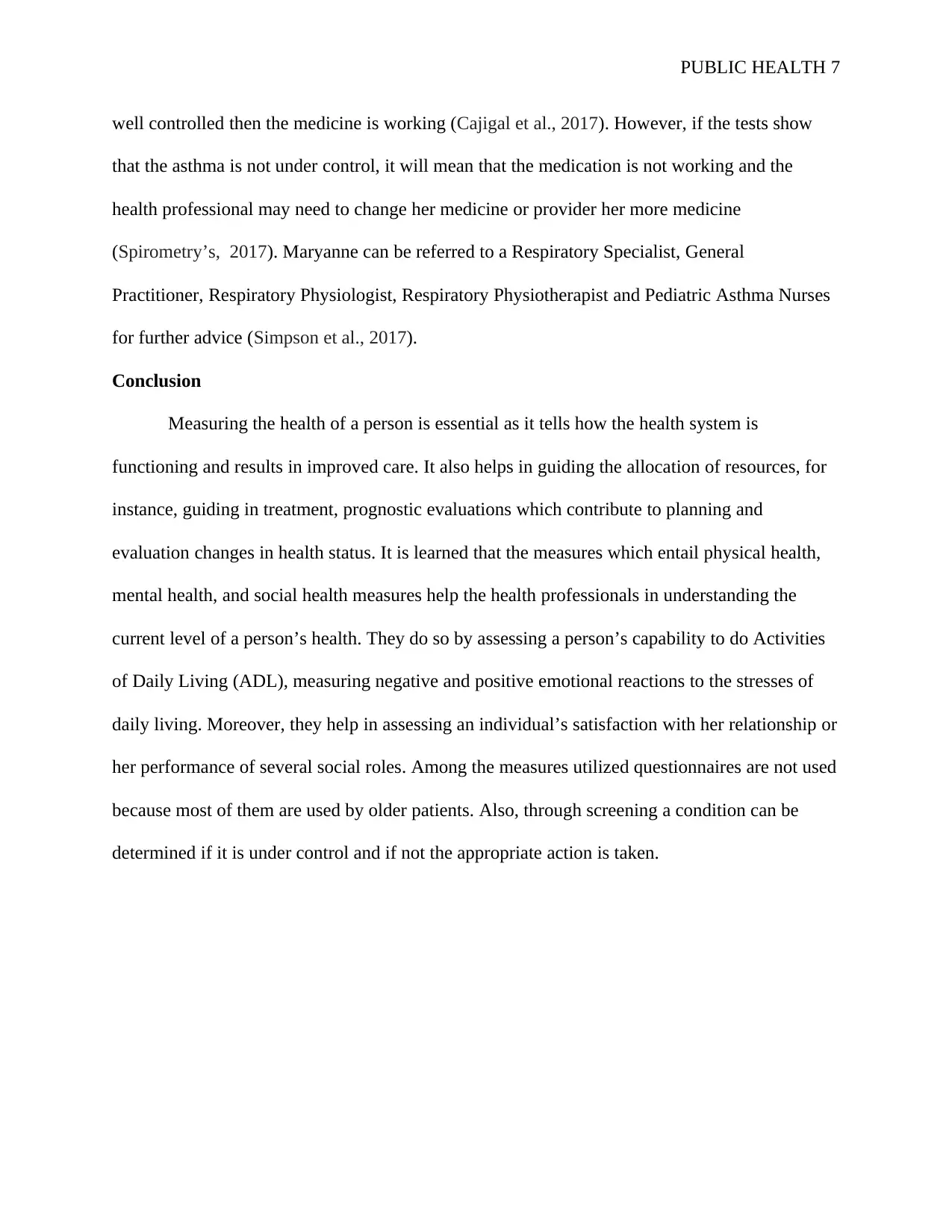
PUBLIC HEALTH 7
well controlled then the medicine is working (Cajigal et al., 2017). However, if the tests show
that the asthma is not under control, it will mean that the medication is not working and the
health professional may need to change her medicine or provider her more medicine
(Spirometry’s, 2017). Maryanne can be referred to a Respiratory Specialist, General
Practitioner, Respiratory Physiologist, Respiratory Physiotherapist and Pediatric Asthma Nurses
for further advice (Simpson et al., 2017).
Conclusion
Measuring the health of a person is essential as it tells how the health system is
functioning and results in improved care. It also helps in guiding the allocation of resources, for
instance, guiding in treatment, prognostic evaluations which contribute to planning and
evaluation changes in health status. It is learned that the measures which entail physical health,
mental health, and social health measures help the health professionals in understanding the
current level of a person’s health. They do so by assessing a person’s capability to do Activities
of Daily Living (ADL), measuring negative and positive emotional reactions to the stresses of
daily living. Moreover, they help in assessing an individual’s satisfaction with her relationship or
her performance of several social roles. Among the measures utilized questionnaires are not used
because most of them are used by older patients. Also, through screening a condition can be
determined if it is under control and if not the appropriate action is taken.
well controlled then the medicine is working (Cajigal et al., 2017). However, if the tests show
that the asthma is not under control, it will mean that the medication is not working and the
health professional may need to change her medicine or provider her more medicine
(Spirometry’s, 2017). Maryanne can be referred to a Respiratory Specialist, General
Practitioner, Respiratory Physiologist, Respiratory Physiotherapist and Pediatric Asthma Nurses
for further advice (Simpson et al., 2017).
Conclusion
Measuring the health of a person is essential as it tells how the health system is
functioning and results in improved care. It also helps in guiding the allocation of resources, for
instance, guiding in treatment, prognostic evaluations which contribute to planning and
evaluation changes in health status. It is learned that the measures which entail physical health,
mental health, and social health measures help the health professionals in understanding the
current level of a person’s health. They do so by assessing a person’s capability to do Activities
of Daily Living (ADL), measuring negative and positive emotional reactions to the stresses of
daily living. Moreover, they help in assessing an individual’s satisfaction with her relationship or
her performance of several social roles. Among the measures utilized questionnaires are not used
because most of them are used by older patients. Also, through screening a condition can be
determined if it is under control and if not the appropriate action is taken.
Paraphrase This Document
Need a fresh take? Get an instant paraphrase of this document with our AI Paraphraser
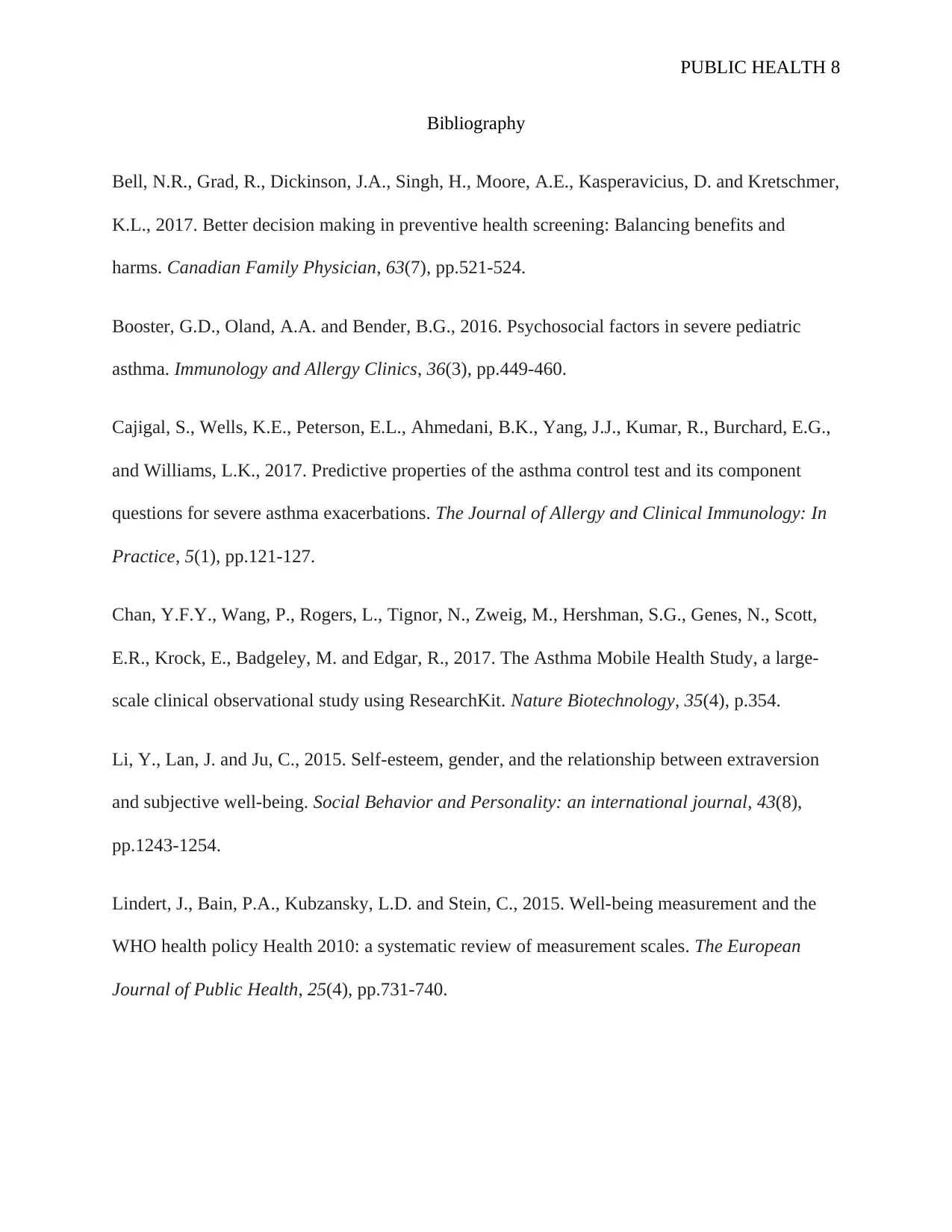
PUBLIC HEALTH 8
Bibliography
Bell, N.R., Grad, R., Dickinson, J.A., Singh, H., Moore, A.E., Kasperavicius, D. and Kretschmer,
K.L., 2017. Better decision making in preventive health screening: Balancing benefits and
harms. Canadian Family Physician, 63(7), pp.521-524.
Booster, G.D., Oland, A.A. and Bender, B.G., 2016. Psychosocial factors in severe pediatric
asthma. Immunology and Allergy Clinics, 36(3), pp.449-460.
Cajigal, S., Wells, K.E., Peterson, E.L., Ahmedani, B.K., Yang, J.J., Kumar, R., Burchard, E.G.,
and Williams, L.K., 2017. Predictive properties of the asthma control test and its component
questions for severe asthma exacerbations. The Journal of Allergy and Clinical Immunology: In
Practice, 5(1), pp.121-127.
Chan, Y.F.Y., Wang, P., Rogers, L., Tignor, N., Zweig, M., Hershman, S.G., Genes, N., Scott,
E.R., Krock, E., Badgeley, M. and Edgar, R., 2017. The Asthma Mobile Health Study, a large-
scale clinical observational study using ResearchKit. Nature Biotechnology, 35(4), p.354.
Li, Y., Lan, J. and Ju, C., 2015. Self-esteem, gender, and the relationship between extraversion
and subjective well-being. Social Behavior and Personality: an international journal, 43(8),
pp.1243-1254.
Lindert, J., Bain, P.A., Kubzansky, L.D. and Stein, C., 2015. Well-being measurement and the
WHO health policy Health 2010: a systematic review of measurement scales. The European
Journal of Public Health, 25(4), pp.731-740.
Bibliography
Bell, N.R., Grad, R., Dickinson, J.A., Singh, H., Moore, A.E., Kasperavicius, D. and Kretschmer,
K.L., 2017. Better decision making in preventive health screening: Balancing benefits and
harms. Canadian Family Physician, 63(7), pp.521-524.
Booster, G.D., Oland, A.A. and Bender, B.G., 2016. Psychosocial factors in severe pediatric
asthma. Immunology and Allergy Clinics, 36(3), pp.449-460.
Cajigal, S., Wells, K.E., Peterson, E.L., Ahmedani, B.K., Yang, J.J., Kumar, R., Burchard, E.G.,
and Williams, L.K., 2017. Predictive properties of the asthma control test and its component
questions for severe asthma exacerbations. The Journal of Allergy and Clinical Immunology: In
Practice, 5(1), pp.121-127.
Chan, Y.F.Y., Wang, P., Rogers, L., Tignor, N., Zweig, M., Hershman, S.G., Genes, N., Scott,
E.R., Krock, E., Badgeley, M. and Edgar, R., 2017. The Asthma Mobile Health Study, a large-
scale clinical observational study using ResearchKit. Nature Biotechnology, 35(4), p.354.
Li, Y., Lan, J. and Ju, C., 2015. Self-esteem, gender, and the relationship between extraversion
and subjective well-being. Social Behavior and Personality: an international journal, 43(8),
pp.1243-1254.
Lindert, J., Bain, P.A., Kubzansky, L.D. and Stein, C., 2015. Well-being measurement and the
WHO health policy Health 2010: a systematic review of measurement scales. The European
Journal of Public Health, 25(4), pp.731-740.
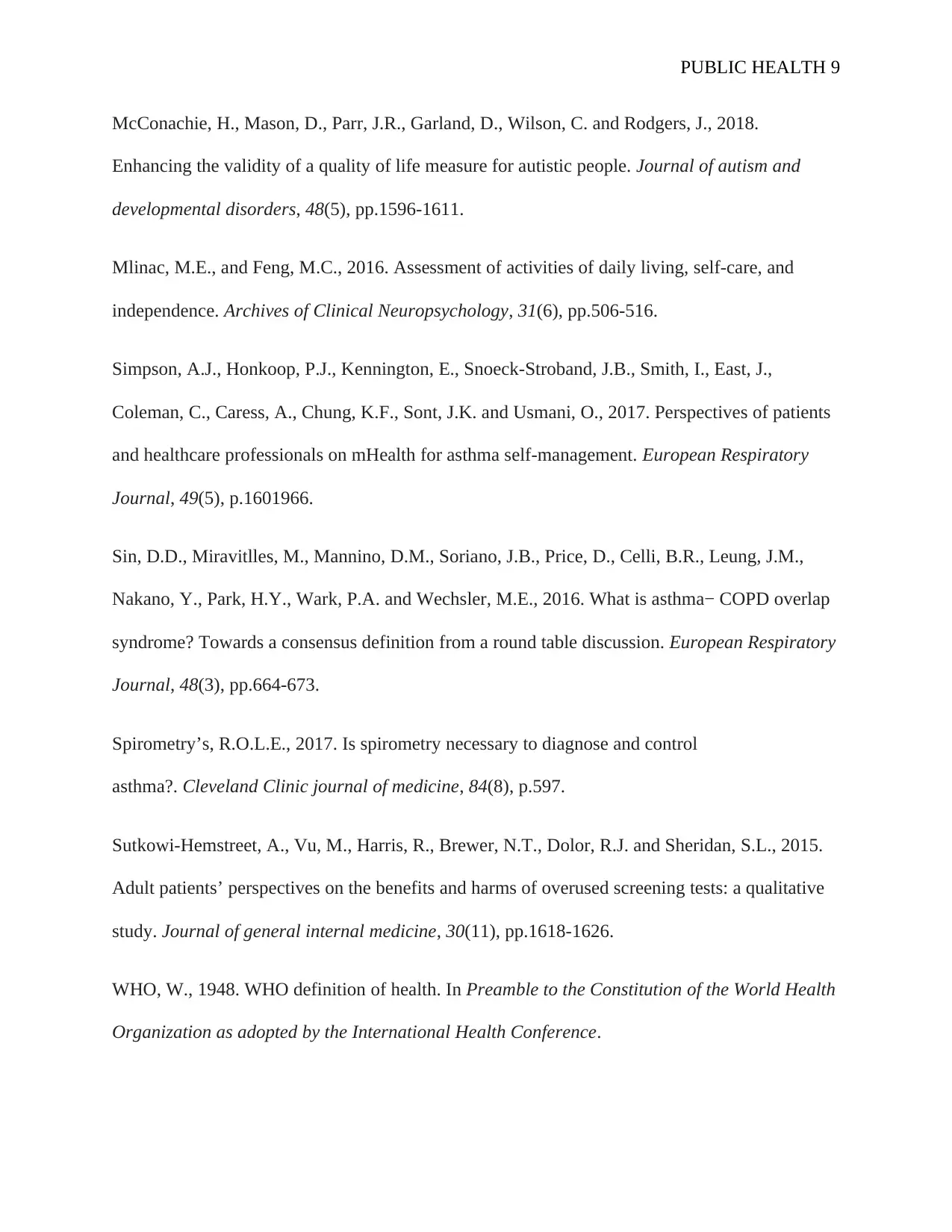
PUBLIC HEALTH 9
McConachie, H., Mason, D., Parr, J.R., Garland, D., Wilson, C. and Rodgers, J., 2018.
Enhancing the validity of a quality of life measure for autistic people. Journal of autism and
developmental disorders, 48(5), pp.1596-1611.
Mlinac, M.E., and Feng, M.C., 2016. Assessment of activities of daily living, self-care, and
independence. Archives of Clinical Neuropsychology, 31(6), pp.506-516.
Simpson, A.J., Honkoop, P.J., Kennington, E., Snoeck-Stroband, J.B., Smith, I., East, J.,
Coleman, C., Caress, A., Chung, K.F., Sont, J.K. and Usmani, O., 2017. Perspectives of patients
and healthcare professionals on mHealth for asthma self-management. European Respiratory
Journal, 49(5), p.1601966.
Sin, D.D., Miravitlles, M., Mannino, D.M., Soriano, J.B., Price, D., Celli, B.R., Leung, J.M.,
Nakano, Y., Park, H.Y., Wark, P.A. and Wechsler, M.E., 2016. What is asthma− COPD overlap
syndrome? Towards a consensus definition from a round table discussion. European Respiratory
Journal, 48(3), pp.664-673.
Spirometry’s, R.O.L.E., 2017. Is spirometry necessary to diagnose and control
asthma?. Cleveland Clinic journal of medicine, 84(8), p.597.
Sutkowi-Hemstreet, A., Vu, M., Harris, R., Brewer, N.T., Dolor, R.J. and Sheridan, S.L., 2015.
Adult patients’ perspectives on the benefits and harms of overused screening tests: a qualitative
study. Journal of general internal medicine, 30(11), pp.1618-1626.
WHO, W., 1948. WHO definition of health. In Preamble to the Constitution of the World Health
Organization as adopted by the International Health Conference.
McConachie, H., Mason, D., Parr, J.R., Garland, D., Wilson, C. and Rodgers, J., 2018.
Enhancing the validity of a quality of life measure for autistic people. Journal of autism and
developmental disorders, 48(5), pp.1596-1611.
Mlinac, M.E., and Feng, M.C., 2016. Assessment of activities of daily living, self-care, and
independence. Archives of Clinical Neuropsychology, 31(6), pp.506-516.
Simpson, A.J., Honkoop, P.J., Kennington, E., Snoeck-Stroband, J.B., Smith, I., East, J.,
Coleman, C., Caress, A., Chung, K.F., Sont, J.K. and Usmani, O., 2017. Perspectives of patients
and healthcare professionals on mHealth for asthma self-management. European Respiratory
Journal, 49(5), p.1601966.
Sin, D.D., Miravitlles, M., Mannino, D.M., Soriano, J.B., Price, D., Celli, B.R., Leung, J.M.,
Nakano, Y., Park, H.Y., Wark, P.A. and Wechsler, M.E., 2016. What is asthma− COPD overlap
syndrome? Towards a consensus definition from a round table discussion. European Respiratory
Journal, 48(3), pp.664-673.
Spirometry’s, R.O.L.E., 2017. Is spirometry necessary to diagnose and control
asthma?. Cleveland Clinic journal of medicine, 84(8), p.597.
Sutkowi-Hemstreet, A., Vu, M., Harris, R., Brewer, N.T., Dolor, R.J. and Sheridan, S.L., 2015.
Adult patients’ perspectives on the benefits and harms of overused screening tests: a qualitative
study. Journal of general internal medicine, 30(11), pp.1618-1626.
WHO, W., 1948. WHO definition of health. In Preamble to the Constitution of the World Health
Organization as adopted by the International Health Conference.
⊘ This is a preview!⊘
Do you want full access?
Subscribe today to unlock all pages.

Trusted by 1+ million students worldwide
1 out of 9
Related Documents
Your All-in-One AI-Powered Toolkit for Academic Success.
+13062052269
info@desklib.com
Available 24*7 on WhatsApp / Email
![[object Object]](/_next/static/media/star-bottom.7253800d.svg)
Unlock your academic potential
Copyright © 2020–2025 A2Z Services. All Rights Reserved. Developed and managed by ZUCOL.





